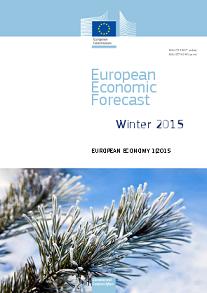European Commission (2015) European Economic Forecast: Winter 2015, European Economy 1|2015, DG for Economic & Financial Affairs, Φεβρουάριος.
GDP growth in the EU remains sluggish. Sputtering investment has so far prevented a broader and more robust acceleration of domestic demand. Amid challenging global conditions, the fall in crude oil prices should provide a welcome boost to growth.
Several important shifts are under way in the global economy. Falling oil and commodity prices are redistributing income from commodity-exporting countries to commodity-importing ones on a massive scale. Strong GDP growth in the US has fuelled expectations of monetary-policy divergence among major advanced economies, which has already provoked large adjustments in bilateral exchange rates. The economic prospects of emerging markets are also diverging; and the factors that led to the extraordinary growth of global trade in the early2000s appear to have weakened.
The friction that occurs as these shifts take place creates a number of vulnerabilities in the global economy. Financial asset prices continued to rise substantially in 2014 but appear vulnerable to a change in risk appetite. The expected tightening of the US Fed’s monetary stance may trigger adjustments in global capital flows. The resilience of commodity-exporting countries will be tested if commodity prices remain low. Geopolitical risks have not abated. All in all, the global outlook is clouded by the risk that economic prospects around the world will diverge further and by the potential for volatile incidents in capital markets.
In the EU, slowly expanding private consumption has been the only constant growth driver since the start of the recovery almost two years ago. Investment faltered in 2014 and remains weak. Longer-term trends such as ageing and declining productivity growth may also have affected short-term investment decisions by reducing expected rates of return. Against this backdrop, monetary accommodation and the shift of the fiscal stance to neutral have so far not been enough to spur growth. Headline inflation has dropped, largely on the back of lower energy prices, which should benefit growth by boosting real incomes. However, inflation expectations for the medium-term have also declined, leading to an increase in real interest rates. In the short run, downside risks have intensified, but new upside risks have also emerged.
In the longer run, are we facing an era of low growth, low investment, low inflation and the occasional storm in global financial markets? Not if the right policies are implemented now with determination. The ECB has just decided a programme of quantitative easing with strong forward guidance that is large enough to stabilise inflation expectations and reduce real interest rates. The easing of the EU’s fiscal policy stance from consolidation to neutral is appropriate for the EU as a whole, but the lack of differentiation among countries reduces its benefits. Public finances would also be much more supportive of long-term growth if expenditure were more focused on investment. The EU Investment Plan and the Commission’s guidance on the application of the Stability and Growth Pact provide a framework that must now be put into practice. Whether and how we reform our labour and product markets today will determine our chances for resource-efficient growth in the long run. These policy areas are intertwined and must be addressed simultaneously.
The recent sharp fall in oil prices should provide a welcome lift to the EU’s GDP growth in the short run. But this blessing would turn into a curse if it diverted policy makers from the formidable challenges that still lie ahead.




